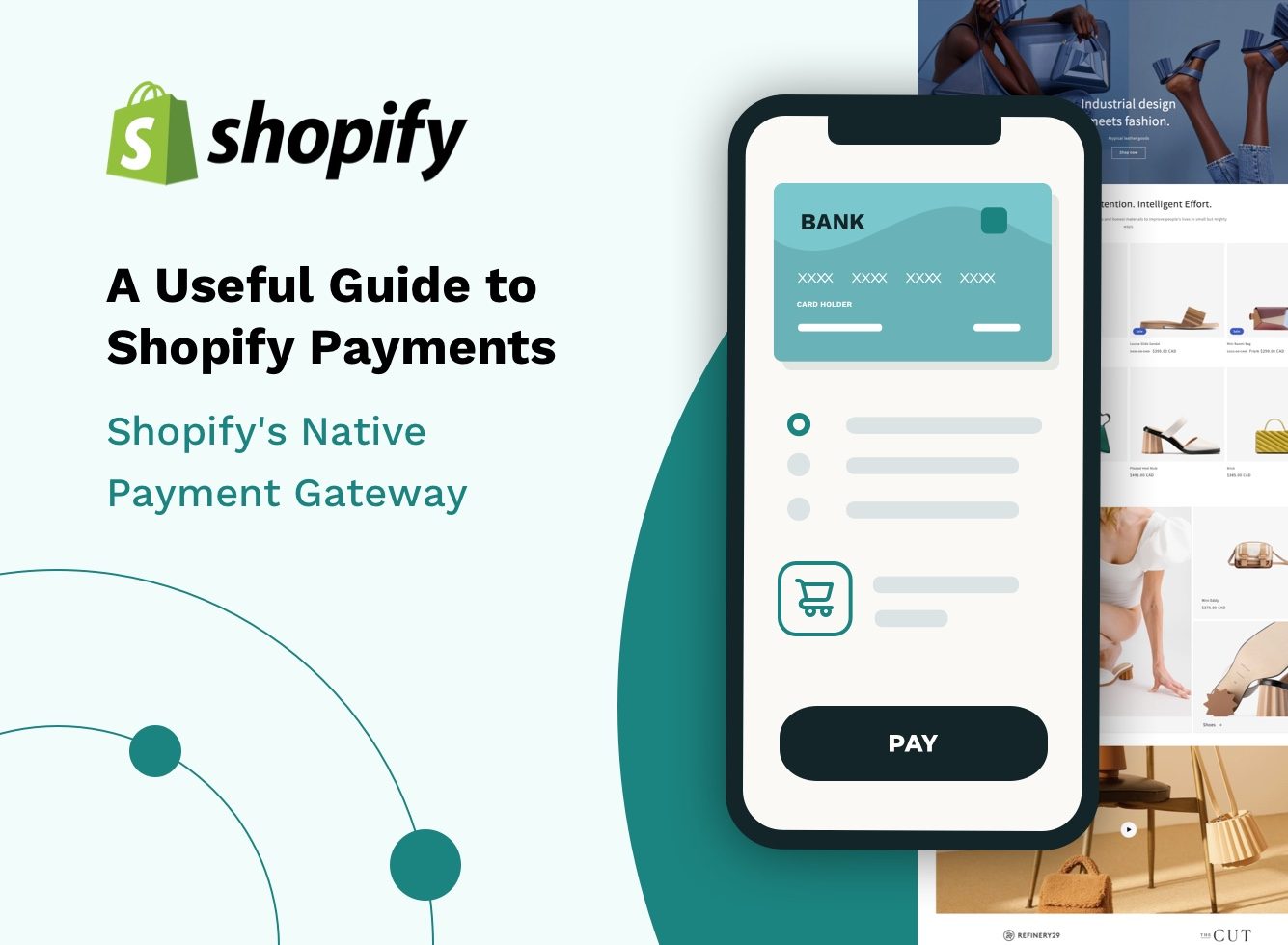A Useful Guide to Shopify Payments – Shopify’s Native Payment Gateway

Research shows us that nearly 70% of all online shopping carts are abandoned. This is a huge problem for eCommerce businesses, but it’s one that can be minimised with a good payment system. When you ensure that the customer journey from first landing on your website to finalising their purchase is as smooth as possible, you are giving your business the best chance to succeed.
Shopify is one of the most popular eCommerce platforms in the world, and for good reason. It’s easy to use, has a wide range of features, and is extremely customisable. One of the things that makes Shopify so great is its native payment system. In this guide, we’re going to take a look at everything you need to know about Shopify Payments, including how to set it up, the different payment methods available, and how to troubleshoot any issues you may have.
What is Shopify Payments?
In the early days of Shopify, online merchants were limited to using a third-party payment provider if they wanted to accept credit card payments. This meant signing up for a separate account with a company like PayPal, and then integrating that account with Shopify. While this wasn’t a huge problem, it did add an extra step to the checkout process, and also meant that Shopify didn’t have as much control over the payment experience.
In 2013, Shopify decided to launch its own payment gateway, Shopify Payments. This allowed Shopify merchants to accept credit and debit card payments directly through their Shopify account, without needing a third-party gateway. This native Shopify payment gateway easily holds its own against any big-name online payment gateway, thanks to its low fees, seamless integration, and worry-free setup.
One of the best things about the native Shopify payment system is that, as a merchant, you aren’t charged third-party transaction fees. You can accept payment from all major credit and debit cards, without having to worry about paying extra fees. This is a huge benefit, as many payment gateways will charge you a fixed amount per transaction (or sometimes a monthly fee) on top of the regular credit card processing fees. When you’re just starting out, every little bit counts, and not having to pay these extra transaction fees can make a big difference to your bottom line.
Which Countries are Supported by Shopify Payments?
Although Shopify makes an effort to be available in as many countries as possible, Shopify Payments is not fully available worldwide. As of today, Shopify payments is only available in the following countries:
- Australia
- Austria
- Belgium
- Canada
- Denmark
- France
- Germany
- Hong Kong SAR
- Ireland
- Italy
- Japan
- Netherlands
- New Zealand
- Singapore
- Spain
- Sweden
- United Kingdom
- United States
Why Should You Choose Shopify Payments as Your Online Payment Gateway?
It goes without saying that choosing a native payment gateway is going to be more convenient than a third-party option. But the benefits of Shopify Payments are not restricted solely to convenience — there are some very real advantages to using Shopify Payments over other gateway providers.
Here are some of the key benefits when you set up Shopify Payments.
Seamless Integration
Since the Shopify payment system is a native online payment gateway, it integrates seamlessly with your Shopify store. This means you don’t have to worry about any complicated setup process, or deal with multiple accounts and logins. Shopify Payments is designed to fit in perfectly with the rest of your Shopify store, for a smooth and streamlined experience.
Multiple Payment Options
When you set up Shopify Payments, you will have the ability to accept a wide range of payment types, including all major credit and debit cards, Apple Pay, and Google Pay. This gives your customers the flexibility to pay in the way that suits them best and makes it more likely that they’ll complete a purchase.
Native Buy Now & Pay Later
With the rise of cost-spreading platforms like Klarna, more and more customers are looking for ways to pay for their purchases over time. Shopify Payment options make it easy to offer this service to your customers through Shop Pay Instalments. This feature allows customers to split the cost of their purchase into 4 interest-free payments, while you get paid fully upfront. It’s a win-win!
Quick & Easy Setup
Setting up Shopify Payments is very straightforward, and can be done directly from your Shopify admin. There’s no need to sign up for a separate account or login — everything is taken care of within your Shopify account. Once you’ve completed the setup process, you’re ready to start accepting payments!
Full Control from One Platform
When you use Shopify’s online payment gateway, all your payments are processed through your Shopify account. This gives you full visibility over your payments, making it easy to track your sales and revenue from one central platform. You can also take advantage of Shopify’s powerful reporting tools to get insights into your business and make data-driven decisions about your future.
Reduced Card Payment Fees
One of the biggest benefits of using the Shopify payment gateway is that you can avoid paying third-party transaction fees. With most payment gateways, you’re charged a fixed amount per transaction on top of the regular credit card processing fees. But with Shopify Payments, there are no extra transaction fees — you’ll only ever pay the standard credit card processing fees and Shopify fees. This can make a big difference to your bottom line, particularly if you’re processing a high volume of transactions.
Multi-currency Support
If you’re selling to customers in multiple countries, then you’ll need an online payment gateway that can support multi-currency transactions. Shopify Payments offers multi-currency support, which means you can accept payments in multiple currencies and have them automatically converted into your home currency. This is a great way to boost your international sales and reach a wider customer base.
Encrypted Data
When it comes to payments, security is always a top priority. The Shopify payment system uses the latest encryption technology to ensure that all your customer data is securely stored and protected. You can rest assured that your payments are in safe hands with Shopify Payments.
Fraud Protection
The Shopify payment system includes fraud protection tools to help you reduce the risk of fraud and chargebacks. These fraud analysis tools are constantly monitoring your account for suspicious activity and will flag any potentially fraudulent transactions. You can then review these transactions and decide whether to cancel or fulfil the order.
Address Verification System (AVS)
AVS is a security feature that helps to protect you from fraud by verifying the customer’s billing address. When AVS is enabled, Shopify will compare the customer’s billing address to the address on file with their credit card company. If there’s a match, then the transaction will be processed as normal. If there’s no match, then the transaction will be declined. This helps to reduce the risk of fraud and protect you from chargebacks.
Card Verification Value (CVV)
CVV is another security feature that helps to protect you from fraud. When CVV is enabled, Shopify will require the customer to enter the CVV code from their credit card during checkout. This helps to verify that the card is present and in the customer’s possession, which reduces the risk of fraudulent transactions.
What are the Requirements for Activating Shopify Payments?
The Shopify payment system can be easily activated from your Shopify admin, where you will need to supply some additional information to complete the activation process. If you’re based in the US for example, this includes:
- Your employer identification number (EIN)
- Your banking information
The information you are required to provide will differ depending on your location. Shopify’s website has a full list of the requirements for each country. Generally, this information will fall into the following categories:
- Information related to the individual creating the Shopify Payments account
- Information associated with your business.
- Information related to the business owner or the senior executive with legal signing authority for the business.
This may mean that you are required to supply a variety of identification documents such as your passport, driver’s licence, or residence. You may also need to provide proof of your home address, such as a utility bill or bank statement. In addition to this, you may be required to send copies of documents related to your business such as your Certificate of Incorporation or tax registration documents.
Once you have gathered all the required information, you can begin the activation process from your Shopify admin. The activation process is relatively straightforward and should only take a few minutes to complete.
How to Set up Shopify Payments
Before you complete the Shopify Payments setup process, you need to decide on your store currency. This is the currency that you want to use for your prices, products, and reports. You can select your store currency from the General settings page in your Shopify admin.
Once you’ve decided on your store currency, you can begin the process of setting up Shopify Payments. This process differs slightly depending on whether you’re using your desktop or mobile device.
From your desktop
- Go to the Payments page in your Shopify admin.
- If you have never set up Shopify Payments before, then you will need to click Complete Account Setup. However, if you already have a third-party gateway account, but you want to switch to Shopify Payments, then you need to click Activate Shopify Payments from within the Shopify Payments box, and then click Activate Shopify Payments in the dialogue section. This will remove your old gateway and allow you to set up Shopify Payments.
- Follow the on-screen instructions to complete the setup process. This will involve entering your bank account details and other information about your business.
- Once you have completed the setup process, click Save.
From your Android mobile device
- Go to your Shopify app and click Store and then Settings.
- From this section, go to Payments.
- If you have never set up Shopify Payments before, then you will need to click Complete Account Setup. However, if you already have a third-party gateway account, but you want to switch to Shopify Payments, then you need to click Activate Shopify Payments from within the Shopify Payments box, and then click Activate Shopify Payments in the dialogue section. This will remove your old gateway and allow you to set up Shopify Payments.
- Follow the on-screen instructions to complete the setup process. This will involve entering your bank account details and other information about your business.
- Once you have completed the setup process, click Save.
From your iPhone mobile device
- Go to your Shopify app and click Store and then Settings.
- From this section, go to Payments.
- If you have never set up the Shopify Payment gateway before, then you will need to click Complete Account Setup. However, if you already have a third-party gateway account, but you want to switch to Shopify Payments, then you need to click Activate Shopify Payments from within the Shopify Payments box, and then click Activate Shopify Payments in the dialogue section. This will remove your old gateway and allow you to set up Shopify Payments.
- Follow the on-screen instructions to complete the setup process. This will involve entering your bank account details and other information about your business.
- Once you have completed the setup process, click Save.
Shop Pay vs Shopify Payments - What's the Difference?
If you’re seeing the words Shop Pay and Shopify Payments being used interchangeably, don’t worry — you’re not alone in your confusion. Many merchants are unsure of the difference between these two terms and often use them interchangeably.
In a nutshell, Shop Pay (formerly Shopify Pay) is the name of Shopify’s built-in accelerated checkout process. This feature allows customers to save their payment and shipping information in their Shopify account, so they can check out faster on future purchases. Think of Shop Pay as the frontend, customer-facing side of Shopify Payments. Customers know to look for the Shop Pay logo during checkout, and they can be confident that their information is being stored securely.
Shopify Payments, on the other hand, is the backend, merchant-facing side of Shopify payment processing. This is the actual online payment gateway that merchants use to process credit cards and other types of payments. Shopify Payments is what the merchant sees when they’re logged into their Shopify account. It’s the platform that manages all the merchant’s payments, settlements, and transfers.
Effectively, Shop Pay and Shopify Payments are two sides of the same coin. Shop Pay is the customer-facing side of Shopify Payments, and Shopify Payments is the merchant-facing side. Both are integral parts of the Shopify payments processing ecosystem.
Shopify Payments FAQs
How much does Shopify Payments cost merchants to use?
The cost of using the Shopify payment system will depend on your Shopify plan. The percentage charge for each transaction will be lower if your Shopify plan is higher. For basic users, the rates start at 2.9% + 30¢ USD for online credit card payments, 3.9% + 30¢ USD for online international and Amex credit card payments, and 2.7% + 0¢ USD for in-person payments. For more information on Shopify Payments pricing, visit Shopify’s website.
How do I get paid if I’m using Shopify Payments?
After you set up Shopify Payments, you will be paid through direct deposit. This means the money from your sales will be deposited directly into the bank account that you provided when you set up your Shopify Payments account. The deposit will happen automatically, and you can arrange payment frequencies from your account settings.
How long does it take for merchants to receive their money from Shopify Payments?
This depends on where you are located, but generally, Shopify Payments pay out within 24 to 72 hours. If you use a Shopify Balance account, you may be able to receive your funds as quickly as 24 hours. It’s important to note that payments received on Friday, Saturday and Sunday will be grouped together and paid as one payment.
Can Shopify Payments hold on to my money?
Sometimes, if there is a case of suspected fraud or some other concern, Shopify will hold on to your money until the issue is resolved. If this happens, you will be notified by Shopify and given instructions on how to proceed. Typically, this can last for anything from 30 to 120 days. If there is a third party involved such as a bank or credit card provider, it may take longer to resolve.
Are there any limits to how much I can process using Shopify Pay?
No, Shopify Payments has no limits on how much you can process. You can use the Shopify payment system to process as many sales as you want, and there are no limits on the amount of money you can receive. No matter how big or small your business is, the Shopify payment gateway can handle it.
Can any type of business use Shopify Payments?
The short answer is no. There are some prohibited businesses that may not use the Shopify payment gateway. This includes financial services providers, such as banks and money transmitters as well as businesses that sell illegal goods or services. For a full list of prohibited businesses, you can check out Shopify’s Terms of Service.
Will Shopify provide me with any kind of protection from chargebacks?
Yes, merchants who use Shopify Payments can use Shopify Protect for free, which will help to protect them from chargebacks. If an eligible chargeback is filed, Shopify will cover the cost of the chargeback.
Shopify Payments - The Answer to All Your Payment Problems
Shopify Payments is the simplest way to accept payments. It’s an all-in-one solution that gives you the ability to take payments both online and in-person. This helps to maximise your sales and give your customers the flexibility to pay how they want. The native Shopify payment gateway is favoured by merchants because it’s easy to use and merchant-friendly with low transaction fees and no monthly costs. But your customers are the real winners — they get a seamless, worry-free payment experience whether they’re paying online or in your store.
If you’re looking to hire Shopify developers, we’re ready to help. Our Shopify agency has years of experience building custom Shopify themes and apps, and we’re experts in Shopify Payments. For more information about how you can provide a smooth shopping experience for your customer, refer to our guide on Shopify tax setup, and Shopify shipping. You can also check out our article on Shopify Online Store 2.0 — the next generation of Shopify eCommerce.





